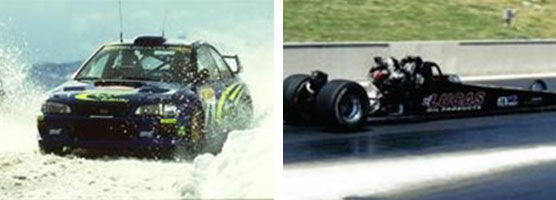Boost Cooler Waterinjectio
Functionality & Knowledge
By using the Boost Cooler, you can expect up to approx. 10-20% more power on charged gasolines engines, 15-25% on Turbodiesels and up to 5-15% on naturally aspirated gasoline engines. - Even on pre-tuned cars.
Thermal Relief

Finally, when the remaining water droplets and water vapour reach the combustion chamber, steam is produced. When the water changes from the liquid to gas state, large amount of heat energy is consumed in sustaining the process. The latent heat of evaporation is 2256kJ/kg, approx. six times more than gasoline.
This chemical process acts as an anti-detonant and also keeps the interior of the engine very clean, so preventing the build-up of carbon “hot spots”. So water is the perfect liquid for regulating excess heat under certain engine-operating conditions and you´ll cool down your EGT, the valves, pistons and turbocharger!
Optimal cooling

The Boost Cooler injection works in three ways: Firstly, when water is injected into the intake system prior to the cylinder head, the small droplets absorb heat from the intake air.
When we apply heat energy to it, its molecules begin to expand: a great deal of heat is absorbed during this process owing to water’s specific heat capacity - approximately 4.2kJ/(kg.K). Next, the small droplets of water start to evaporate. And so the intake air charge is cooled still further (up to 60°C and more).
Video presentation
Early days of Waterinjection
Boost Cooler History
Water injection was evaluated scientifically in the 1930’s by H. Ricardo who demonstrated that one can basically double the power output of an engine using water/methanol. The first widespread use was during WWII on supercharged and turbocharged aircraft. In 1942, the German Luftwaffe increased the horsepower of the Focke-Wulf 190D-9 fighter aircraft from 1776HP to 2240HP using 50/50% water/methanol injection.
The allies soon followed by fitting the P51 Mustang and other high performance aircraft with water/methanol injection. Following the war, the turboprop aircraft industry used water/methanol injection and called it the “automatic power reserve system (APR)” for use in hot or high altitude take off. It surfaced again in the 60’s when GM used a system on the OEM turbo Corvair.

BF-109 using Water-/Methanolinjection
Waterinjection in Formula-Sports

When turboengines became popular in Formula 1 in the 1980s, the potential of water/methanol injection was recognized anew. Renault and Ferrari were the first teams to use a water injection in 1983. From a boost pressure of about 2.5 bar, water was injected into the intake tract.
A 12 liter tank was installed in the side box of the car. The additional weight was more than compensated for by correspondingly higher ignition potential and the associated higher power.
From this point onwards the use of water/methanol injection in high-performance turboengines was indispensable if one were to keep up the lead. Due to the enormous increase in power and the associated higher risks, the use of turbocharging technology was prohibited. Thus, the end of the water injection within the Formula 1 was inevitably sealed.
Waterinjection in street legal cars

The 99 Turbo was first introduced in 1977 at the Frankfurt International motor show. The Saab 99 Turbo brought the relatively new technology of turbocharging into the reach of many. The 99 Turbo had a Garret T3 turbocharger unit fitted to the normal 2 litre 99 engine. The optional waterinjection generated more power and cooling at the same time.
In 1998, Subaru of Japan produced a widebody, 2-door, Impreza called the 22B STi. The 22B was used to commemorate both Subaru's 40th anniversary as well as the 3rd consecutive manufacturer's title for Subaru in the FIA World Rally Championship. On the release of the sales, all 399 sold out from 30 minutes to 48 hours, depending on the report. It produce 350 PS (345 hp/257 kW) at 6000 rpm and 363 N·m (225 ft·lbf = 37.0 kgf·m) of torque at a lower engine speed of 3200 rpm.
Waterinjection in Rally and Dragracing

The Water-/Methanol Injection technology is used mainly in the various turbochargers of the rally and touring cars (E.g. Subaru WRX, Ford Cosworth, Lancia Delta, Skoda Fabia, Alfa Q4). The use of water injection in combination with turbomotors is almost obligatory in dragster racing and tractor pulling.
The Water-/Methanol Injection also plays an important role in extreme performance areas. The desired cooling can always be achieved by the quantity of liquid injected, in addition, leaning of the engine is prevented with the addition of methanol, so that a maximum of supercharging pressure or efficiency can be obtained from the turbocharger (or G supercharger/compressor).
Waterinjection these days

In collaboration with BMW M GmbH, the BMW M4 GTS was developed with water injection. The first prototype was used as a safety car in the MotoGP 2015. In the following year the M4 GTS appeared with water injection in series production.
By using the Water Injection, the temperature of the combustion air, for the M TwinPower turbo-series six-cylinder, was lowered by 25 °C. During the injection of the fine spray, the power increases from 425 to 493 hp and the maximum torque from 550 to 600 Nm. Equipped with a 5-liter tank, it is sufficient to refill the tank every fifth time the fuel gets refilled.



